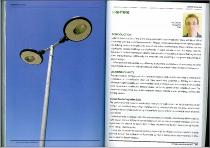JavaScript is disabled for your browser. Some features of this site may not work without it.
- ResearchSpace
- →
- Research Publications/Outputs
- →
- Book Chapters
- →
- View Item
| dc.contributor.author |
Osburn, L

|
|
| dc.date.accessioned | 2009-04-14T12:40:53Z | |
| dc.date.available | 2009-04-14T12:40:53Z | |
| dc.date.issued | 2009-02 | |
| dc.identifier.citation | Osburn, L. 2009. Lighting. Green building handbook South Africa. Vol. 1 (A guide to ecological design) pp 9 | en |
| dc.identifier.isbn | 9780620427241 | |
| dc.identifier.uri | http://hdl.handle.net/10204/3309 | |
| dc.description | Copyright: 2009 Green Building | en |
| dc.description.abstract | Lighting consumes between about 29-35% of the energy used within commercial office space while lighting only consumes about 11% of the energy used in a residential environment. Through conscientious design of the lighting systems, the lighting load can be reduced by more than half within both environments. These estimates can vary significantly as a consequence that buildings vary significantly in shape and size as well as functions. Additionally, the more inefficient a building is, the greater the potential to accrue savings. Office environments operate very differently to residential environments. Offices have a very high level of occupancy during office hours and are then largely unoccupied while residential buildings have highly sporadic occupancy levels throughout the year. Consequently, the same intervention will have different results depending in which environment it operates | en |
| dc.language.iso | en | en |
| dc.publisher | Green Building | en |
| dc.subject | Lighting | en |
| dc.subject | Fluorescent tubes | en |
| dc.subject | Light Emitting Diodes | en |
| dc.subject | LED | en |
| dc.subject | Motion detection switching | en |
| dc.subject | Day lighting | en |
| dc.subject | Light switching | en |
| dc.subject | Green building handbook South Africa | en |
| dc.title | Lighting [A guide to ecological design] | en |
| dc.type | Book Chapter | en |
| dc.identifier.apacitation | Osburn, L. (2009). Lighting [A guide to ecological design]., <i></i> Green Building. http://hdl.handle.net/10204/3309 | en_ZA |
| dc.identifier.chicagocitation | Osburn, L. "Lighting [A guide to ecological design]" In <i></i>, n.p.: Green Building. 2009. http://hdl.handle.net/10204/3309. | en_ZA |
| dc.identifier.vancouvercitation | Osburn L. Lighting [A guide to ecological design]. [place unknown]: Green Building; 2009. [cited yyyy month dd]. http://hdl.handle.net/10204/3309. | en_ZA |
| dc.identifier.ris | TY - Book Chapter AU - Osburn, L AB - Lighting consumes between about 29-35% of the energy used within commercial office space while lighting only consumes about 11% of the energy used in a residential environment. Through conscientious design of the lighting systems, the lighting load can be reduced by more than half within both environments. These estimates can vary significantly as a consequence that buildings vary significantly in shape and size as well as functions. Additionally, the more inefficient a building is, the greater the potential to accrue savings. Office environments operate very differently to residential environments. Offices have a very high level of occupancy during office hours and are then largely unoccupied while residential buildings have highly sporadic occupancy levels throughout the year. Consequently, the same intervention will have different results depending in which environment it operates DA - 2009-02 DB - ResearchSpace DP - CSIR KW - Lighting KW - Fluorescent tubes KW - Light Emitting Diodes KW - LED KW - Motion detection switching KW - Day lighting KW - Light switching KW - Green building handbook South Africa LK - https://researchspace.csir.co.za PY - 2009 SM - 9780620427241 T1 - Lighting [A guide to ecological design] TI - Lighting [A guide to ecological design] UR - http://hdl.handle.net/10204/3309 ER - | en_ZA |









